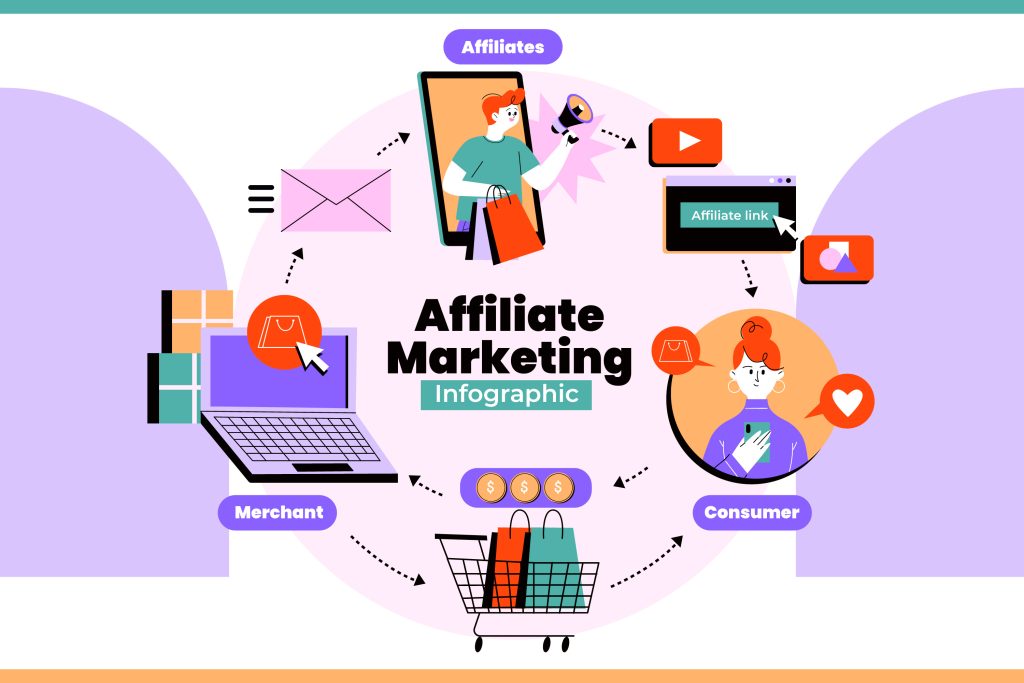Affiliate marketing is a popular way to earn money online by promoting other people’s products and earning a commission for each sale made through your referral. It’s a performance-based business model, meaning you only make money when someone takes a specific action (such as purchasing a product) through your affiliate link.
Here’s a detailed guide on how to make money with affiliate marketing:
1. Choose a Niche
- Focus on something you’re passionate about: It’s easier to market products if you’re genuinely interested in the niche you’re focusing on. This will also help you create authentic, engaging content for your audience.
- Consider profitability: Choose a niche that has both consumer demand and affiliate programs that offer good commissions. Popular niches for affiliate marketing include technology, health and wellness, personal finance, beauty, and travel.
2. Find Affiliate Programs or Networks
You’ll need to join affiliate programs or networks that connect affiliates (like you) with merchants who are selling products or services.
- Affiliate Networks: These platforms manage multiple affiliate programs in one place. Some popular ones include:
- Amazon Associates (great for beginners with a huge variety of products)
- ClickBank (digital products like e-books and courses)
- ShareASale
- CJ Affiliate (formerly Commission Junction)
- Rakuten Marketing
- Direct Affiliate Programs: Some companies run their own affiliate programs, and you can join them directly. Many software and SaaS companies (like Shopify, Bluehost, or SEMrush) offer their own affiliate programs.
When selecting an affiliate program, look for:
- Good commission rates: Some programs offer a percentage of sales, while others offer a fixed fee.
- Reliable tracking and payment systems: You want to make sure that the affiliate program tracks your sales correctly and that you get paid on time.
- High-quality products: Promoting products that are useful and relevant to your audience is crucial. It builds trust and credibility.
3. Create High-Quality Content
Content is key to affiliate marketing success. Without good content, it’s hard to drive traffic and persuade people to click on your affiliate links.
- Blog Posts & Reviews: Write detailed product reviews or tutorials, explaining how the product works and why it’s valuable. Include your affiliate links in these reviews.
- Example: If you’re promoting a camera, you could write a blog post like “Top 5 Cameras for Beginners: A Comprehensive Review” and link to the products using affiliate links.
- YouTube Videos: You can create video content where you talk about the product, demonstrate its use, or give reviews. YouTube is a great platform for affiliate marketing, as you can add affiliate links in the description of your videos.
- Social Media Content: Share your affiliate links on platforms like Instagram, TikTok, or Pinterest, where you can post product recommendations, stories, or tutorials. Use features like swipe-up links or link in bio to drive clicks.
- Email Newsletters: If you have an email list, you can send curated content with affiliate links to your subscribers. Just be mindful of being transparent and not overloading them with sales-heavy emails.
4. Drive Traffic to Your Content

Even the best content won’t make you money unless people see it. You need to drive traffic to your content. There are several ways to do this:
- SEO (Search Engine Optimization): Optimize your blog posts, videos, and content for search engines to appear in organic search results. Use tools like Google Keyword Planner or SEMrush to find keywords people are searching for and create content around those topics.
- Paid Ads: Invest in paid advertising on Google, Facebook, Instagram, or YouTube. Target the right audience based on their interests and behaviors to drive relevant traffic to your affiliate links.
- Social Media Marketing: Build an active presence on platforms like Instagram, Facebook, and Pinterest. Share valuable content, engage with followers, and promote products you’re affiliated with.
- Influencer Marketing: If you have a significant social media following, you can collaborate with brands on sponsored content or promote their affiliate products to your audience.
- Email Marketing: Build an email list and nurture your subscribers with valuable content and affiliate offers. You can automate the process with tools like Mailchimp or ConvertKit.
5. Incorporate Affiliate Links Naturally
When adding affiliate links to your content, it’s important to integrate them in a way that feels natural and not overly sales-y. You want your audience to trust your recommendations. Here are a few ways to do that:
- Contextual Linking: Include affiliate links where they make sense within the content. For example, if you’re writing about cooking, link to kitchen gadgets or food-related products in your article.
- Comparison Tables: If you’re comparing different products (e.g., best laptops for gaming), include affiliate links to each of the products in the comparison table.
- Clear Calls to Action: Use calls to action like “Check out this product” or “Get this offer today” to encourage readers to click through.
- Disclosures: Be transparent about your affiliate relationships. According to FTC guidelines, you must disclose that you may receive a commission if someone makes a purchase through your link.
6. Track and Optimize Your Efforts
Keep an eye on the performance of your affiliate links and content. Most affiliate programs provide reporting tools where you can track clicks, conversions, and commissions.
- Identify High-Converting Content: See which of your content drives the most affiliate sales and create more of that type of content.
- Test and Experiment: A/B test different strategies, such as varying the placement of your affiliate links, trying different calls to action, or promoting different products.
- Use Analytics Tools: Google Analytics and affiliate network dashboards will give you insight into which channels and products perform the best.
7. Scale Your Efforts
Once you’ve found what works, it’s time to scale:
- Expand Your Content Library: Create more content targeting different keywords or customer pain points to reach a broader audience.
- Increase Traffic: Invest more time and money in growing your traffic. Consider running ads, building more backlinks, or even working with influencers.
- Diversify Affiliate Programs: Partner with multiple affiliate programs to offer a wider range of products to your audience. This can help mitigate the risk of relying too heavily on one source of income.
Tips for Success in Affiliate Marketing:
- Be patient: Affiliate marketing is not a get-rich-quick business. It can take time to see significant income, especially when you’re starting.
- Build trust with your audience: The more your audience trusts you, the more likely they are to buy through your affiliate links.
- Offer value: Focus on providing value to your audience rather than just promoting products. If you help your audience solve problems, they’ll appreciate your recommendations.
- Stay updated: Affiliate marketing trends, tools, and strategies evolve. Keep learning and adapting to stay competitive.

Conclusion
Affiliate marketing can be a highly lucrative income stream, especially when you focus on providing value, building an engaged audience, and strategically promoting products that align with your niche. By selecting the right affiliate programs, creating high-quality content, and driving traffic to that content, you can build a sustainable affiliate marketing business. However, it requires patience, consistency, and optimization to see significant results.


